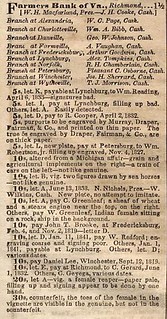
About UsThe Numismatic Bibliomania Society is a non-profit organization promoting numismatic literature. For more information please see our web site at coinbooks.org SubscriptionsThose wishing to become new E-Sylum subscribers (or wishing to Unsubscribe) can go to the following web page link MembershipThere is a membership application available on the web site Membership Application To join, print the application and return it with your check to the address printed on the application. Membership is only $15 to addresses in the U.S., $20 for First Class mail, and $25 elsewhere. For those without web access, write to: David M. Sundman, Secretary/TreasurerNumismatic Bibliomania
Society AsylumFor Asylum mailing address changes and other membership questions, contact David at this email address: dsundman@LittletonCoin.com SubmissionsTo submit items for publication in The E-Sylum, just Reply to this message, or write to the Editor at this address: whomren@coinlibrary.com
BUY THE BOOK BEFORE THE COINYou won't regret it! |
- WAYNE'S WORDS: THE E-SYLUM MAY 20, 2012
- SKLOW MAIL BID SALE NO. 16 CLOSES JUNE 2, 2012
- NEW BOOK: NATIONAL COMMEMORATIVE MEDALS 2ND EDITION
- NEW BOOK: DIVA FAUSTINA: COINAGE AND CULT IN ROME
- NEW BOOK: THE FEEL OF STEEL: BANK-NOTE ENGRAVING IN THE U.S.
- NEW BOOK: A CONCISE CATALOG OF U. S. MILITARY PAYMENT CERTIFICATES
- MORE ON HISTORY OF COLLECTING CONFEDERATE STATES PAPER MONEY
- MORE ON JOHN COFFEE 1928 - 2012
- E-VERSIONS OF A GUIDE BOOK OF U.S. COINS
- AUTHORS SOUGHT FOR ANA CONVENTION BOOK SIGNINGS
- MORE HANS SCHULMAN STORIES
- LELAND HOWARD OF THE TREASURY DEPARTMENT
- NOTES FROM E-SYLUM READERS: MAY 20, 2012
- FROM TEXAS TO THE MOON WITH JOHN LEONARD RIDDELL
- QUICK QUIZ: WHAT DOES N.I.T. ON BRYAN MONEY STAND FOR?
- QUERY: WHO IS THAT GENT WITH LINCOLN AND GRANT?
- BOOK LEADS COLLECTOR TO RARE 1983 COPPER-ALLOY CENT
- ARTICLE CLAIMS 1870-S THREE DOLLAR GOLD PIECE FOUND IN A BOOK
- ANNOYING AUCTION HOUSE SALE TERMS
- QUERY: SUTLER PAPER MONEY CATALOG SCHEME
- QUERY: HOW TO PUBLISH A NUMISMATIC BOOK IN 2012
- BRITISH NUMISMATIC JOURNAL AVAILABLE ONLINE
- MORE NUMISMATIC BOOKS ON CD/DVD
- HARVEY STACK ON THE ADAMS FAMILY COIN COLLECTION
- AN INTERVIEW WITH DR ANDREW BURNETT OF THE BRITISH MUSEUM
- WAYNE'S NUMISMATIC DIARY: MAY 20, 2012
- RENOVATIONS AT THE OLD SAN FRANCISCO MINT
- SAN FRANCISCO MINT CELEBRATES 75TH ANNIVERSARY
- LONDON POLICE RAID COIN COUNTERFEITING OPERATION
- CANADIAN MOOSE MONEY AND CARIBOU COINS
- ARTICLE HIGHLIGHTS WEST POINT MINT FACILITY
- FEATURED WEB PAGE: KISSI MONEY
WAYNE'S WORDS: THE E-SYLUM MAY 20, 2012

New subscribers this week include Daniel Stepan. Welcome aboard! Also, Beth Deisher is continuing as a subscriber. She writes: "While I will no longer be at Coin World, I do intend to continue to be interested and active in numismatics, just in a different way." We now have 1,556 email subscribers, plus 177 followers on Facebook.
This week we open with information on five new numismatic books. What's not to love? Other topics include John Coffee, Leland Howard, Hans Schulman and John Riddell, plus Bryan Money, Sutler Money, and numismatic e-books and CDs.
To learn more about National Commemorative Medals, the history of collecting Confederate States of America paper money, over-looked Pteridophytic Binomials and the Adams Family coin collection, read on.
Have a great week, everyone!
SKLOW MAIL BID SALE NO. 16 CLOSES JUNE 2, 2012
Our mail bid sale no. 16 closes June 2, 2012. it features the library of Charles Moore and many other fine consignments. the catalog is viewable on our web site. Individuals on our mailing list will have already received their catalog. Bidders may enter their bids via mail, telephone, email or fax. the sale closes Saturday June 2, 2012 at 8pm Mountain time. However, any bids left on our answering machines or sent by email or fax on or before midnight on closing day will be accepted.
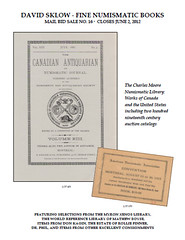 DAVID SKLOW - FINE NUMISMATIC BOOKS
DAVID SKLOW - FINE NUMISMATIC BOOKS
P.O. BOX 6321
COLORADO SPRINGS, CO 80934
TEL: (719) 302-5686
FAX: (719) 302-4933
finenumismaticbooks@aol.com
www.finenumismaticbooks.com
FUTURE AUCTION SCHEDULE
SALE # 17 - OCTOBER 6, 2012
SALE # 18 - FEBRUARY 2, 2013
SALE # 19 - JUNE 1, 2013
SALE # 20 - OCTOBER 5, 2013
SALE # 21 - FEBRUARY 1, 2014
SALE # 22 - JUNE 7, 2014
SALE # 23 - OCTOBER 11, 2014
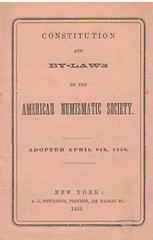 680. American Numismatic Society. CONSTITUTION AND BYLAWS OF THE AMERICAN NUMISMATIC SOCIETY; ADOPTED APRIL 6TH,
1858. New York, 1858. A. J. Townsend, printer. 8 pp. 32 mo. [12.5 x 8 cm]. Original salmon paper covers, black
printing. The first printing of this rare booklet; Ex: Bowers and Merena Sale of the Armand Champa Library Part One
lot 0034 where cataloguer Charles Davis notes it is the first printing of the second oldest numismatic society in
the country; Davis 27: In his work American Numismatic Literature, 1992. Charles Davis states in the notes
that the example in his book dated September 1858 is the second edition, but, the ANS library catalogue lists one
dated April 6th, 1858; a true piece of the American Numismatic Society's history; a slight scuff to the bottom right of front cover, else fine; Fine. (500.00)
680. American Numismatic Society. CONSTITUTION AND BYLAWS OF THE AMERICAN NUMISMATIC SOCIETY; ADOPTED APRIL 6TH,
1858. New York, 1858. A. J. Townsend, printer. 8 pp. 32 mo. [12.5 x 8 cm]. Original salmon paper covers, black
printing. The first printing of this rare booklet; Ex: Bowers and Merena Sale of the Armand Champa Library Part One
lot 0034 where cataloguer Charles Davis notes it is the first printing of the second oldest numismatic society in
the country; Davis 27: In his work American Numismatic Literature, 1992. Charles Davis states in the notes
that the example in his book dated September 1858 is the second edition, but, the ANS library catalogue lists one
dated April 6th, 1858; a true piece of the American Numismatic Society's history; a slight scuff to the bottom right of front cover, else fine; Fine. (500.00)
NEW BOOK: NATIONAL COMMEMORATIVE MEDALS 2ND EDITION
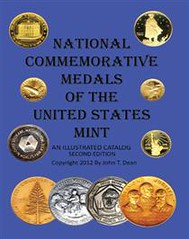 "National Commemorative Medals of the United States Mint"
"National Commemorative Medals of the United States Mint"
Second Edition, May 2012
By: John T. Dean
Contact: John Dean
turner_medals@yahoo.com
Website: http://www.jtdean.com/USMedals/buybook2.html
This is the Second Edition of the National Commemorative Medals book originally released in 2008. John T. Dean is the Author and Publisher of Record for this self-published medals reference guide, now with a corresponding Price Guide and Checklist to assist collectors in acquiring these very desirable and collectible medals.
An illustrated catalog reference of National Commemorative medals struck by the United States Mint. These medals are effectively replacements for the missing commemorative coins of the 1954 to 1982 era. Many are quite rare and quite collectible. This reference has been compiled to provide collectors with one source of information, which is difficult to locate, being the US Mint does not keep thorough records of the modern mint medals production. Many years were used compiling this information for the numismatic arena. Collectors of these medals will find the information contained in this book most valuable in completing their collections.
Author is a numismatic collector/dealer of over fifty years, a member of the ANA, TAMS and local area clubs.
"Second Edition Book (8x10 Hard Copy - Color - 101 Pages)- List Price $49.95
First Edition Illustrated Price Guide and Checklist (8.5 x 11 Paperback - Color) - List Price $14.95
Buy them both for $48 with free shipping."
Please visit the website at www.jtdean.com/USMedals/buybook2.html for prices and ordering information.
NEW BOOK: DIVA FAUSTINA: COINAGE AND CULT IN ROME
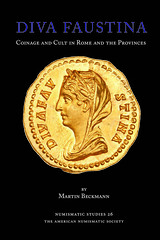 Diva Faustina. Coinage and Cult in Rome and the Provinces
Diva Faustina. Coinage and Cult in Rome and the Provinces
by Martin Beckmann (Numismatic Studies 26, 2012)
ISBN 978-0-89722-322-5
ISSN 051-7404-X
184 pages, 36 plates, 18 die-charts
Price: $95
Members: $66.50
FREE SHIPPING on all domestic retail orders placed before June 30th, 2012. $5.00 OFF SHIPPING on all international retail orders placed before June 30th, 2012. This is a pre-order publication that will ship in August 2012.
The coinage struck posthumously in the name of Faustina the Elder, wife of the Roman emperor Antoninus Pius, was the largest such issue ever produced by the mint of Rome. Until now it has been impossible to date these coins with any accuracy, and thus difficult to determine their place in imperial ideology. This study definitively resolves the chronological difficulties of these undated issues by means of die study of Diva Faustina's gold and bronze coinage. This new understanding of the coinage then forms the basis for a study of the iconographic commemoration of Faustina in all media throughout the empire. It sheds significant new light on the changing nature of the cult of Faustina during (and perhaps after) the lifetime of her husband Antoninus Pius, on the nature and mechanisms of family commemoration in the Antonine period in general, on the cult of the divi divaeque, and especially on the role of imperial women, living and dead, in the presentation of the public image of the emperor both in Rome and in the provinces. The volume contains illustrated catalogues of the sestertii and aurei in the name of Diva Faustina, including forgeries and a statistical analysis, co-authored with Warren Esty.
Martin Beckmann is assistant professor in the Department of Classics at McMaster University and author of The Column of Marcus Aurelius: The Genesis and Meaning of a Roman Imperial Monument.
This is a pre-order publication that will ship in August 2012
For more information or to order, see: numismatics.org/Store/NS26
NEW BOOK: THE FEEL OF STEEL: BANK-NOTE ENGRAVING IN THE U.S.
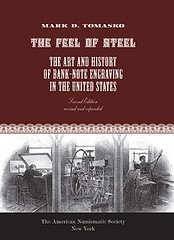 The Feel of Steel: The Art and History of Bank-Note Engraving in the United States
The Feel of Steel: The Art and History of Bank-Note Engraving in the United States
by Mark D. Tomasko (2012)
Hardcover, 180 pp.
ISBN-13: 978 089722 321 8
List Price: US$120.00
Member Price: US$84.00
This is a pre-order publication that will ship in August 2012.
The Feel of Steel provides an unusual look into the two-hundred-year history and the process of bank-note engraving in the United States, a beautiful art brought to its peak in America in the nineteenth century. Part I traces the history, with particular attention to the American Bank Note Company, the small bank-note firms founded after the Civil War, and the Bureau of Engraving and Printing. The decline of the industry in the late twentieth century closes the history.
Part II lays out the process of designing, engraving, and printing bank-note-engraved documents. Part II also contains an extended discussion of the artwork origins of the picture engraving, information found in few other places. Part III introduces the members of American Bank Note's picture-engraving department at thirty-year intervals in the twentieth century, shown in group photographs and with an illustration of each man's work.
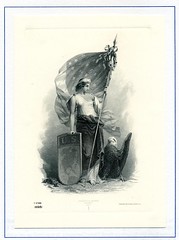 This revised edition has 50% more illustrations than the original Bird and Bull fine press limited edition published in 2009. Besides the numerous illustrations (many in color), there are copious notes, a bibliography, and an extensive index, all adding to the volume's research value. As no book on bank-note engraving would be complete without at least one sample of actual engraving, the frontispiece of the ANS edition of The Feel of Steel is the reprinted title and vignette from a nineteenth-century stock certificate. The reader can therefore actually experience the "feel
of steel," the tactile quality of intaglio printing.
This revised edition has 50% more illustrations than the original Bird and Bull fine press limited edition published in 2009. Besides the numerous illustrations (many in color), there are copious notes, a bibliography, and an extensive index, all adding to the volume's research value. As no book on bank-note engraving would be complete without at least one sample of actual engraving, the frontispiece of the ANS edition of The Feel of Steel is the reprinted title and vignette from a nineteenth-century stock certificate. The reader can therefore actually experience the "feel
of steel," the tactile quality of intaglio printing.
Mark D. Tomasko is a collector, writer, and researcher on bank-note engraving, who has written more than thirty articles on the subject, in addition to giving many talks and mounting several museum exhibits.
Mark Tomasko writes:
I thought it would be desirable to make the information in The Feel of Steel: the Art and History of Bank-Note Engraving in the United States more available to both collectors and libraries because there is little similar literature. While the Bird and Bull Press edition of the book is in some major research libraries, an expensive fine-press book in a very small edition is not a generally available reference work.
Fortunately the American Numismatic Society was interested in publishing a trade edition of the book. The biggest change is 50% more illustration than in the fine-press edition. Since security engraving is a graphic art, illustrations are critical, and the revised edition provides some important additional graphic matter. Among the additions are a full-page illustration of the Fairman Draper Underwood broadside with the Audubon grouse engraving; an 1856 letterpress price sheet from Jocelyn Draper Welsh listing prices in great detail for engraving and printing bank notes; the Columbian Exposition award diploma of 1892-93, one of the Bureau's finest products; progressive proofs for a Major Tint (the colored background) for a Brazilian note of 1919; a number of additional examples of vignettes, portraits, bank notes, and other documents; and, as well, examples of vignettes or portraits done by virtually every engraver shown in the three photographs of the American Bank Note Company picture-engraving department in Part III.
A book on security engraving would be incomplete without at least one intaglio print, and every copy of the trade edition of The Feel of Steel has an engraved frontispiece, the engraved header for the National Bank of Commerce in New York stock certificate.
In terms of text and arrangement, the trade edition of The Feel of Steel is similar to the fine-press edition, with Part I consisting of a summary history of the bank-note industry in the United States; Part II describing the process of designing, engraving and printing the documents, with particular attention to vignettes and their artwork; and Part III showing the three photographs of the ABN picture-engraving department in the twentieth century. The major changes in the text relate to discussion of the additional illustrations. As in the original edition, there is a useful bibliography and many footnotes. The trade edition also includes a much more extensive index.
For more information or to order, see: numismatics.org/Store/Steel
To read about the first edition, see: NEW BOOK: THE FEEL OF STEEL - BANK NOTE ENGRAVING IN THE U.S. (www.coinbooks.org/esylum_v12n39a04.html)
NEW BOOK: A CONCISE CATALOG OF U. S. MILITARY PAYMENT CERTIFICATES
Carlson R. Chambliss has just written a published a new book on MPCs entitled "A Concise Catalog of U. S. Military Payment Certificates." The book is published under the imprint of the Speckles Press and was printed by Sheridan Books of Ann Arbor, Michigan. The book is large format and 152 pages long. It is in full color, and this is the first MPC book to be in this format.
It lists and prices all 15 series of MPCs both in normal and replacement form. A new replacement census that lists about 3500 notes is given, which is far more than are given in any earlier compilations. There are several other datasets including ones never before seen. The POGs that are presently in use in the Middle East are also listed in detail, and almost 500 varieties of these (up though the 15th issue) are listed and numbered. Also discussed are specimen and proof notes, voided notes, errors, fancies, counterfeits, and replicas.
There is an annotated bibliography, and the resources material includes a discussion of the portraits that appear on MPCs. This is an essential source for anyone interested in military money or in U. S. Federal paper money in general. The book is priced at $26.00 postpaid within the USA, but quantity discounts are available and are quite substantial provided a fair number of books are ordered. Prices to foreign countries will be higher due to much greater shipping costs. The author can be contacted by telephone at 1 - 610 - 683 - 6852, by post at P. O. Box 804, Kutztown, PA 19530, and by email at crchamblis@verizon.net (one 's').
MORE ON HISTORY OF COLLECTING CONFEDERATE STATES PAPER MONEY
Pierre Fricke writes:
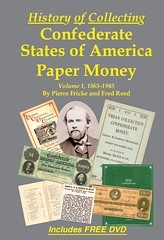 We wrote the book to provide a view of how people collected Confederate paper money over the years in a complete context ordered by time with vignettes of the people, collections, books, auctions, dealers, events as a backdrop - including touching on related areas such as CSA "coins", Southern States paper money and CSA Bonds.
We wrote the book to provide a view of how people collected Confederate paper money over the years in a complete context ordered by time with vignettes of the people, collections, books, auctions, dealers, events as a backdrop - including touching on related areas such as CSA "coins", Southern States paper money and CSA Bonds.
We also wanted a book to put the condition census of rare notes and provenance in context which is included on the DVD. There are also many other collecting tools such as checklists, exhibit lists, old auction catalogs' CSA sections, recent auction results and 7 years' worth of my blog articles on the DVD.
As we see carrying on today, people collected these fascinating artifacts of one of the most significant periods in US history in a variety of ways and from the wealthy collecting thousands of notes to the modest which can also be an interesting collection. We stopped at 1945 as the book was passing 300 pages (it ended up being 340) and had plenty more to add from 1945-2015. We wanted an affordable, high value package that was easy to pick up and read and not be too big and intimidating. It will take us a few more years to get 1945-2015-16 done and wanted something out during the 150th anniversary.
Several things were learned... ten come to mind tonight.
1. Collecting CSA paper money started in earnest in the numismatic sense in 1865. Mostly in Boston in the northeast down to Richmond Virginia.
2. It took time to get to stable type categorization system. Actually did not happen until the 1960s when Criswell's type system took hold (with some arguable errors or items of contention one might add). The variety system continues to evolve, which you can see across the various books and auction of the period (and now in the 21st century again - Volume 2 topic).
3. Counterfeits did not become more popular until after this period.
4. The so-called "essay" notes or fantasy notes T-47/XX-2 and T-48/XX-3 were not sought out by the vast majority of these earlier collectors - later popularized by Chase and especially Criswell post 1945. (An aside, there is little chance these are "essays" in the sense of "proofs" as is commonly thought of an essay as the quality is poor and there are too many of them). Still, they are fascinating and a great add to a type set.
5. CSA paper money did not just go up in value, though it increased greatly over the 1865-1945 period driven by more collectors/interest and inflation. The 1890s and 1930s were tough on CSA paper money (and many other things as these were depression years mostly).
6. Most collectors focused on the major designs (types) and interesting varieties. Many collectors also had plate letter/number (plen) sets, e.g., A-H of the major varieties which drove huge collections of thousands of notes - but most of these were very cheap... many notes for less than 0.01 each. A few went for all documented varieties - none that we know of got there during the period (Dr Ball in his 1987 sale remains the closest, though the potential exists for at least one 21st century collector (not me) to get closer - no one has achieved what Dan Holmes did in large cents yet - may never happen).
7. While there was some interest in other types of error, military signature issues on $100 7.3% interest notes and other non-variety anomalies, collecting these became more popular in the past 20 years - topic for volume 2.
8. Many of the CSA collectors also had significant interests in other areas of numismatics - especially early US coins (large cents being most popular) and obsolete / colonial paper money.
9. CSA paper money was not plated much at all during this period in the auction catalogs - these plates were mostly reserved for early American coins (up to 1815, though some later issues too) from colonials to gold.
10. Grading interpretations were all over the map... in general, grading was not much of an issue during this early period as most CSA paper money was "cheap" and had shallow price curves (people looked for an example that was decent, but most did not drive hard for census level notes). What we call Ch VF-XF or better might have been called AU or Unc. Today this is a different situation with higher prices and steep price curves for some types and varieties - another volume 2 topic.
Fred Reed writes:
The only thing that I'd add to the excellent commentary that Pierre sent you about our new book is that these early first Confederate collectors were for the most part really more antiquarians than hobbyists. They were studious and meticulous, albeit voracious in their antiquarian appetites.
They were interested in everything antique (including genealogy, autographs, paper documents, letters and printed ephemera), and these curious rebel notes were part of an overall interest in times past. Many of these first collectors, of course, also had personal remembrances of the war; some had served (mostly in the Union Army), and these notes were curios, and for the Yankees evidences that the rebellion was not only a "lost cause" but a very flawed one at that.
You can quote me on this, although it won't make me any friends with the highly partisan neo-Confederates of the world. AND you can quote that too!
To read the earlier E-Sylum article, see: NEW BOOK: HISTORY OF COLLECTING CONFEDERATE STATES PAPER MONEY (www.coinbooks.org/esylum_v15n18a03.html)

MORE ON JOHN COFFEE 1928 - 2012
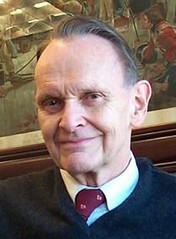 COFFEE, John Main Jr., of Brookline, MA, died Tuesday, May 8th, 2012, in Brookline at age 83. He was a Unitarian Minister, longtime Professor of History at Emerson College, and an avid collector of transportation tokens. He was born November 20, 1928, in Tacoma, WA, to John Main Coffee and Lillian (Slye) Coffee. He attended public schools in Tacoma and Washington, DC, and graduated from the Fishburne Military School in Waynesboro, VA, in 1947. He earned a bachelor's degree from Yale University in 1951 and two master's degrees in Divinity and Theology from Harvard Divinity School in 1954 and 1956.
COFFEE, John Main Jr., of Brookline, MA, died Tuesday, May 8th, 2012, in Brookline at age 83. He was a Unitarian Minister, longtime Professor of History at Emerson College, and an avid collector of transportation tokens. He was born November 20, 1928, in Tacoma, WA, to John Main Coffee and Lillian (Slye) Coffee. He attended public schools in Tacoma and Washington, DC, and graduated from the Fishburne Military School in Waynesboro, VA, in 1947. He earned a bachelor's degree from Yale University in 1951 and two master's degrees in Divinity and Theology from Harvard Divinity School in 1954 and 1956.
While at Harvard, John was editor of The Scribe, the Divinity School student publication. He was ordained into the Unitarian ministry in 1954 and was installed as minister at the First Church in Roxbury, MA. For 20 years at First Church, John was very involved in the Church's youth group, "The Putnam Guild," making lifelong friends with many in the group as well as others throughout New England who were members of the Liberal Religious Youth (LRY) movement. He also served as president of the Boston Ministers Association.
In 1966, John's teaching career began almost by chance. The dean of Emerson College, Richard Pearce, was a deacon at First Church, and invited John to teach history part-time. In 1970, he became a full-time faculty member and taught a variety of courses, among them Western Civilization, History of England, The World Since 1914, U.S. Constitutional History, and History of the Bible. Fiercely devoted to his students, and outspoken against the Vietnam War, John was able to save many boys from the draft through his testimony. One of the most beloved teachers at Emerson, John is a rare two-time recipient of the College's Gold Key for outstanding teaching (1987 and 1993). He is also the co-author (with Richard L. Wentworth) of A Century of Eloquence: The History of Emerson College, 1880-1980, published in 1982. After 39 years of teaching at Emerson, John retired at age 76, receiving the title of Professor Emeritus in 2005.
At age 11, John began collecting coins, an activity that led to token collecting. He became one of the founding members of the American Vecturist Association (AVA), the only national society of transportation token collectors in the United States. Organized in 1948, the AVA began with 33 charter members consisting mostly of bus drivers and a few numismatists and college students; since then, its membership has grown into the hundreds. From 1949 to April 2012, he was Editor of approximately 775 issues of the AVA's monthly newsletter, The Fare Box. He is also co-editor (with Harold V. Ford) of The Atwood-Coffee Catalogue of United States and Canadian Transportation Tokens, now in its 6th edition (2007): it describes in detail, and gives the approximate market value of every known transportation token issued in the US and Canada. John's other token-related publications include the books Automobile Washing Tokens (co-author Harold V. Ford, 1986), and Land Company and Real Estate Tokens (1991), as well as numerous articles.
Until his death, John owned the largest collection of transportation tokens in the world. "The thing about tokens," he once told Newsday, "is that they give you a wonderful sense of this country. A quarter is a quarter, no matter where you are, but a token from Ashland or Mount Vernon has a character all its own. It is a piece of history and a part of American character."
A diehard traveler averse to flying, John drove or rode trains across the U.S. every summer for decades. He loved to explore small towns where he could collect and research old and new tokens. He was a welcome visitor of friends in California, and of his mother in Tacoma. Never married, John is survived by loving friends, students, and fellow collectors. Information about services for John can be found at JS Waterman & Son: www.bostonharborsidehome.com .
To read the original obituary, see:
obits.dignitymemorial.com/dignity-memorial/obituary.aspx?n=John-Coffee
&lc=4643&pid=157548949&mid=5100882
Longtime Emerson faculty member and Professor Emeritus of History John M. Coffee Jr. died on May 8, 2012. He was 83 and a resident of Brookline, Massachusetts.
Coffee taught at the College for 35 years, and was the author (with Richard Wentworth '79) of a large volume on the history of Emerson College, A Century of Eloquence.
He was universally beloved by his colleagues and "adored" by his students. He was known as a talented storyteller who brought history alive in his classroom.
The 1981 Emersonian yearbook was dedicated to Coffee, in honor of his teaching methodology and his ability to make historical events relevant to modern life.
Through one of his students, Coffee was introduced to author Stephen King; King enjoyed the encounter so much that he named the main character in The Green Mile for Coffee.
To read the complete article, see: Emerson mourns the loss of Rev. John Coffee (www.emerson.edu/news-events/emerson-college-today/emerson-mourns-loss-rev-john-coffee)


January, 1950 and January, 2012 issues of The Fare Box
Images courtesy David Gladfelter
David Gladfelter writes:
John used to write about the cross country train rides (between Boston and Tacoma, to visit his family and friends, with stops en route) in the Fare Box. Enjoying rail travel fits in with transportation token collecting. He published and mailed the summer issues from Tacoma.
True to his ministerial calling, he regularly noted the passing of AVA members with brief remarks about them on the Fare Box's front pages. He collected people as well as tokens. When you sent an article into him for publication, you always received a polite acknowledgment via postcard usually with some more information from him about your topic.
The adage "to get something done, ask a busy man" fit him nicely.
AVA Curator Keith Haney adds this detail:
The Fare Box was started in July 1947 by R. L. Moore as a token collector's checklist, and he abdicated with the Dec.1948 issue. The AVA was formed on October 31, 1948 in New York City, and a young student at Yale, John Coffee, became charter member #14. The AVA took over the Fare Box as a house organ with the January 1949 issue #19 and named John, then 20, and D. Meade Peebles, another 20-ish and charter member #13, as co-editors. The October Fare Box, issue #28, explained the Mr. Peebles was no longer involved, and named John Coffee as sole editor of the Fare Box. Our February 2012 issue was John's 749th consecutive issue as editor, a period spanning 62 years and five months.
A tough old cowboy from South Texas counseled his grandson that if he wanted to live a long life, the secret was to sprinkle a pinch of gun powder on his oatmeal every morning.
The grandson did this religiously to the age of 103 when he died.
He left behind 14 children, 30 grandchildren, 45 great-grandchildren, 25 great-great-grandchildren, and a 15-foot crater where the crematorium used to be.
To read the original article, see: Long Live The Cowboy (www.gcfl.net/archive.php?funny=6675)
To read the earlier E-Sylum article, see: JOHN COFFEE 1928 - 2012 (www.coinbooks.org/esylum_v15n20a05.html)
E-VERSIONS OF A GUIDE BOOK OF U.S. COINS
Last week, Scott Barman stated that he was unable to buy a copy of A Guide Book of United States Coins (the "Red Book") in e-book format. Dennis Tucker of Whitman Publications writes:
Actually, we've had the e-version available for quite a while, now, and it's been publicized in The E-Sylum and elsewhere. We've had a strong response --- thousands of coin collectors purchased the 2012 e-book edition.
Chris Fuccione writes:
Scott Barman mentioned that the Red Book is not available in e-book format. It is available on Amazon for the Kindle and Kindle reader app for smart phones and iPod/iPhone/iPad. I have not bought it yet because I was hoping to find out from some of your readers how the charts and tables are converted to e-book format. If I were to buy it, it would be to read on a third generation iPod Touch.
Here is a link to it on Amazon:
www.amazon.com/The-Official-Red-Book-ebook/dp/B005EHQETA/
ref=sr_1_5?s=digital-text&ie=UTF8&qid=1337025560&sr=1-5
Scott Barman also mentioned the CoinsHD app for the iPad from the Money Museum in Zurich. There is also an non-HD version of the app for the iPhone/iPod: itunes.apple.com/app/coins-moneymuseum/id305885817?mt=8 .
Tim L. Shuck of Ames, IA writes:
I wanted to comment about digital book availability, specifically Scott Barman's claim that the Red Book is not available in ebook form.
But it is, listed on the iTunes site for $9.99, along with several other titles, including the Cherrypickers' Guide. The selection is not huge, and as noted on iTunes, requires iBooks 1.3.1 or later and iOS 4.3.3 or later. I didn't purchase the ebook copy because, being unaware of its availability, I had already ordered the printed version. Next year I'll probably get the ebook version.
I also received an email today, via my MetaCoin website, that the Official Blackbook Price Guide to U.S. Coins is also now available as an ebook, for $8.99, readable using Adobe Digital Editions. There's no charge to download and preview, so assume payment is needed to load a copy to a personal digital device.
I am a supporter of digital information, but can understand why some publishers are cautious in their transition to ebooks. Those who expect all coin information to be freely available on the internet may be surprised some day to find the supply of new books has dried up. Doing things well requires time, often a lot of time, and it's not unreasonable for authors and publishers to expect to get paid for their efforts.
Chris Fuccione adds this review of the e-book version:
On the May 13th edition of The E-Sylum there was a comment that A Guidebook of United States Coins was not available in e-book format. I am not sure about the availability of it for the other e-book readers but it is available in the Amazon Kindle store. A few months ago I saw this but was hesitant of buying this because part of what makes the Red Book the Red Book was the charts and I was afraid that I would not be able to see them in this format (I am using the Kindle app and a 3rd gen. iPod Touch).
With the way the e-book was set up, if you want to see a chart or a close-up of a coin you put your thumb and two fingers on it and then stretch it out and then magnify it and move it around. The two things that I noticed that I hope they are able to fix next year or on a update is that there are a few charts that start on the bottom of a page and continue on the next page. Also, if you are not careful clicking on the charts on the lower part of the page you will get the go-to section of the app.
For the most part I saw very few spacing errors and no grammatical errors. For an e-book that is very good. I have seen some translations that were almost unreadable. This is not one of them.
The only other problem I have with this is the table of contents. They follow the format that is in the dead tree version where they will list the denominations in the table of contents but you have to flip pages to get to the type of coin you want. In book format this is not a problem. But in e-book format this is a major problem because you can't flip through pages that quick.
Let's say you are interested in looking up information on Mercury Head Dimes. You go to the Table of Content and then go to the dimes section. From there you have to go through every dime series before the Mercury Head. This can take forever. I would rather see the table of contents broken down further to include the type of coins to relieve this problem.
To read the earlier E-Sylum article, see: MORE ON ELECTRONIC BOOKS (www.coinbooks.org/esylum_v15n20a09.html)
AUTHORS SOUGHT FOR ANA CONVENTION BOOK SIGNINGS
Want to host a book signing during the World's Fair of Money?
The ANA's Dwight N. Manley Library wants to highlight numismatic authors and literature during the World's Fair of Money, Aug. 7-11 in Philadelphia. If you've written a numismatic book in the past few years and would like to host an author signing at the ANA Area, the library would be happy to arrange it.
Author signings will be promoted in The Numismatist, in the World's Fair of Money show program, on www.worldsfairofmoney.com, through email blasts to members, on the ANA's social media sites and other areas.
Slots are available Tuesday through Saturday. If an author intends to sell their books during the signing, they must supply their own stock.
For more details or to sign up, contact Library and Communications Director RyAnne Scott at 719-482-9867 or scott@money.org. Please respond by June 8.
KOLBE & FANNING NUMISMATIC BOOKSELLERS
MORE HANS SCHULMAN STORIES
I am fascinated by the reminiscing over the late Hans M.F. Schulman. It reminds us that time is indeed fleeting. In the old Miami (Florida) Coin Club we had an aged Russian emigre, the late Andrew Kelpsh, author of "The Rubles of Peter the Great and his Successors" in The Numismatist. Andy was really old school and HATED Hans for his unswerving determination to make every bit of brass trash "the rare opium weight money of the Boonga-Boonga tribe," every vaguely coin-like medal into an "unpublished pattern coin," notably all Hitler medals, and his perpetual romanticizing of every common "foreign' coin into an historic rarity.
The late John J. Ford spoke before NBS at least twice reminiscing over picking up junk wrought iron from a soon to be demolished inner city slum house, possibly in Cincinnati, He was using the rusty metal as a walking stick, brought it back to his bourse table and absent-mindedly set it down. The late William Fox Steinberg asked if he could have the iron, soon came back and told Ford he'd pay his entire bourse and hotel bill if John could get him more of these iron rods! Ford did, discovering them piled on Hans' bourse table with a sign "West African Kissi Pennies! The coin with a soul!" and a hefty price tag! This was how the great Howard D. Gibbs collection was built...
Andy Kelpsh was diagnosed with incurable colonic cancer soon after. His widow sent all of his marvelous stock to Hans M.F. Schulman. I don't know if she was ever paid. See the New York Numismatic Club Centennial History for his rather widely publicized record of non-payment to consignors.
The first auction catalogue I read as a kid was Hans' "Public Auction - Remarkable Collection of Crowns of the World," Sept. 21, 1956. This slim, orange covered catalogue personified all of these Schulman quirks and horrified me since I was a purist at the time. I eventually learned of the American tendency to swoon over exotic foreign accents, "Ooooh, he must know EVERYTHING! Just listen to that accent!!!
Hans remained a promoter of fantasy stories until his death, including the fantasy value assigned to his firm when it went public. To bring up the supposed value, his partner threw in the Schulman library that Hans claimed was still his personal property and which he lost in the debacle of Schulman Coin and Mint.
Hans had many fans, including J. Oliver Amos, publisher of Coin World, who tried to induce Schulman to move to remote Sidney, Ohio, when the paper was new and remained a bobby-soxer fan until Schulman's death. One fine day in the mid 1970's I acquired a copy of Hans' long out-of-print Coin Collectors Almanac, written mostly by Hans Holzer, later of occult publishing fame. The book first came out in 1946 and was a nine-day wonder. I asked Hans to autograph it and he wrote a couple of long paragraphs of glowing prose about the beauties of Sidney, the greatness of Alexander and his writing for Coin World, on and on! Yes, he was certainly suave.
Hans' father Moritz died at the Sobibor concentration camp. The senior branch of the House of Schulman in Amsterdam was always embarrassed by his American gyrations. Looking back on Hans' career and comparing his pleasantly accented depredations to the wholesale looting of later dealers and such entities as the Franklin Mint, it's possible to believe that perhaps his offenses were comparatively minor.
Toward the end of his life, Hans tied up with Asset Services Inc., an investment era operation that moved out significant numbers of U.S. coins to "investors" across the U.S.
Harvey Stack writes:
The constant query about Hans Schulman, who I knew personally, together with his five wives, jolted my memory and all the stories true and false attributed to him. The odd and curious items mentioned were all part of the Howard Gibbs collection, as Howard, at different times, did great work for Hans and his catalogs.
Zita, his last wife, was a great numismatist, and though she tried to convert his various ways and habits of building a numismatic company, Hans was the playboy of the industry during his time in business.
I remember vividly his adventures and dealings with King Farouk , and the ways he was able to convince the King to try to be a numismatist. Actually, he helped Stack's sell parts of the Col. E.H.R. Green Collection of Gold Coins to the King and was somewhat instrumental in the sale of the 1933 Double Eagle, which was made "legal" , before it was shipped to Egypt.
He opened his retail shop on 45th Street after World War II, to be just around the corner from Stack's on 46th Street in New York, to attempt to attract some of the overflow that Stack's had developed for the location in midtown New York.
To read the earlier E-Sylum article, see: MORE ON HANS SCHULMAN (www.coinbooks.org/esylum_v15n20a16.html)
LELAND HOWARD OF THE TREASURY DEPARTMENT
LeLand Howard became the czar of the Office of Gold and Silver Operations and imposed regulations in 1961 which limited without a license from the O.G.S. importation of all gold coins.
It created a hardship, as the application for import approval (or dis- approval) took from 3 weeks to several months. Any coins to be brought in had to stay where they were. Collectors and dealers had to pay for them to the sellers, and never knew what would be licensed and what could not be licensed.
The firm of Stack's in late 1963 was offered a splendid collection of World Gold Coins assembled by a client and collector in the Netherlands, and we applied for a license to bring it into the U.S. and sell it at Public Auction. The collection contained many coins of the 16th through the 19th Century, and as I recall about 50 which were struck or dated after 1933.The whole collection contained close to 1000 different coins.
After months and months inquiring when we would get the license, the O.G.S, denied a number of coins, and the collector in The Netherlands said he "would not break up his collection because of the regulations "without explanation" in place. But he did promise to hold the collection for us and give us the opportunity of getting an ADMINISTRATION HEARING at the Treasury Department. In late 1966 we presented our case.
First of all, the Office never listed or gave the Criteria for Import License. They ruled as the coins were presented, accepted or denied, without explanation. At the hearing beside being the main witness of our case, (with a prominent Washington D.C. attorney at my side,) I explained that the rules were not evident and that the actions by the Treasury was arbitrary and capricious. Backing my claim was Henry Grunthal, who was Director of the American Numismatic Society , together with both Stefanellis. who were joint curators of the Smithsonian. After a lengthly hearing Stack's WON the case. The examiner felt that the OFFICE OF GOLD AND SILVER OPERATIONS actions were Arbitrary and Capricious.
However, (because we believe of the long standing of LeLand Howard in the Department) the O S.G. denied license. We were going to go higher, but our attorney learned if we let it go for a few months, there was evidence that things would change. In late 1967 LeLand Howard retired from the Department (with all the bells and whistles for long service) and within one month the rulings were rescinded.
Unfortunately, the client had earlier in 1967 lost patience with the united states rulings and regulations and sold the collection overseas. Stack's won the battle, but lost the war. But as it eased the import of Gold Coins I guess it was worth it.!!
NOTES FROM E-SYLUM READERS: MAY 20, 2012
On Looking Truly Remarkable
Last week Brett Irick submitted a picture with this note:
Jim Charlton, an Ontario Numismatic Association founding member, attended the ONA convention last weekend. He is in great shape for a 100 year old. I am pictured on his left.
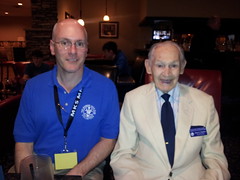 Allan Speedy of Auckland, New Zealand writes:
Allan Speedy of Auckland, New Zealand writes:
If you are indeed 'pictured on his left' then you must be the fellow in the beige jacket and the fellow in the blue tee-shirt must be the 100 year-old Jim Charlton! If that is indeed the case you look truly remarkable FOR YOUR AGE!!!
To read the earlier E-Sylum article, see: CENTENARIAN JIM CHARLTON ATTENDS ONTARIO CONVENTION (www.coinbooks.org/esylum_v15n20a06.html)
Issued vs. Unissued Obsolete Bank Notes
Dave Bowers writes:
Regarding the Circulated vs. Unc question, 99.9% of old-time collectors of obsolete bank notes issued by state-chartered banks 1782-1866 strongly prefer signed and issued notes, generally available in worn grades from very low to VF or EF to owning Uncirculated never-issued notes.
To read the earlier E-Sylum article, see: ON HIGH CONDITION VS ACTUAL USAGE (www.coinbooks.org/esylum_v15n20a10.html)
It Takes a Scholar To Tell You What's Not on Google
Len Augsburger writes:
Regarding books on the Internet - any monkey can type a search term into Google, but it takes a scholar to tell you what's *not* on Google!
To read the earlier E-Sylum article, see: MORE ON ELECTRONIC BOOKS (www.coinbooks.org/esylum_v15n20a09.html)
On the Franklin Parisian Masonic Lodge Medal
Paul Bosco writes:
The Franklin piece in Baldwin's brought 5000 Pounds. Baldwin's have moved up to a 20% buyer's fee, so 5000 Pounds hammer is just about $10,000, a Ford-like price. I should certainly think it is a masonic jeton, rather than a medal, and it may appear in French catalogs of the series. Can't say I have looked, never having had to catalog this very rare item.
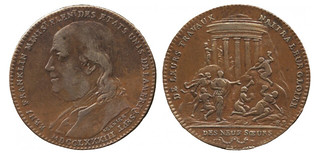
Michel Prieur forwarded a link to a listing of one of these, which has a good deal of information in French. See: www.cgb.fr/monnaies/vso/v11/fr/monnaiesad01.html
It is cataloged as a jeton.
To read the earlier E-Sylum article, see: QUERY: FRANKLIN PARISIAN MASONIC LODGE MEDAL INFORMATION SOUGHT (www.coinbooks.org/esylum_v15n20a23.html)
More on Counterfeit-Detecting Marking Pens
Craig Eberhart writes:
Didn't we go over "..the Usefulness of Counterfeit-Detecting Marking Pens" several times before?
The pens use an ink containing iodine, which turns dark/black when exposed to starch. Because starch is used in most if not all wood-based papers, any counterfeits made using this paper will be detected using one of these pins. However, higher quality counterfeits using cotton or linen fibers may bypass such detection. One could make real currency appear to be fake by soaking it with water that contains starch, but it might not be one of those experiments that should be carried out in a public forum. Even though the Secret Service doesn't seem to care too much about numismatic coin forgeries, I believe they become quite excited about currency reproductions!
To read the earlier E-Sylum article, see: MAN ARRESTED FOR CARRYING A REAL $50 BILL (www.coinbooks.org/esylum_v15n19a28.html)
A Book on How to Fold Money
Ken Berger writes:
 I see that there is still interest in folding money. Attached is a scan of a book from my library about folding money. It was published in 1968 and is 135 pages. Although it says Volume Two, I have never seen Volume One.
I see that there is still interest in folding money. Attached is a scan of a book from my library about folding money. It was published in 1968 and is 135 pages. Although it says Volume Two, I have never seen Volume One.
Also, I have three of those shirts made from folded money. My aunt, Doris Irizarry, learned to make them and gave them to me years ago. You will also note that my shirts each have a necktie, whereas the previous one you pictured did not.
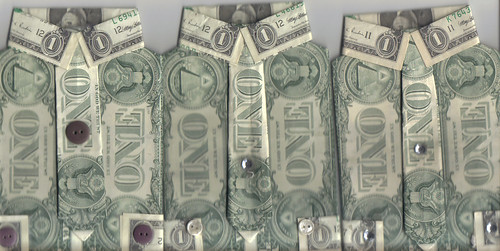
To read the earlier E-Sylum article, see: NOTES FROM E-SYLUM READERS: MAY 13, 2012: A Folded Banknote Shirt (www.coinbooks.org/esylum_v15n20a13.html)
On Family Dynasty Numismatic Firms
Last week Dick Johnson wrote that:
- There are several two- and three-generation numismatic firms in America, but not many.
- We have no family dynasty numismatic firms in America like existed in England, notably Spinks and Seabys.
Jim Duncan of New Zealand writes:
I would not have included Seaby's, as sadly they are no more, but I WOULD have included Baldwin's, where there is still a Baldwin working.
To read the earlier E-Sylum article, see: (www.coinbooks.org/esylum_v15n20a08.html)
More on Jewish Use of the Hexagram
Ed Hohertz writes:
Below is a little more information to predate Jewish use of the hexagram that was mentioned is the last issue:
Concerning the hexagram/Star of David/Seal of Solomon etc., there are earlier Jewish numismatic connections with the symbol than listed last week. In the German State of Brandenburg two Jewish mintmasters used this as their mark on coins from 1565 to1591. The same is true for a 15 kreutzer coin from Moravia dated 1659. It was also used in the Netherlands on a burial pass token for Jewish funerals to leave Amsterdam around 1670. But there were also many other, non-Jewish uses of the symbol over the years, from a good luck charm to an alchemical symbol to Masonic use etc. Many areas used the symbol. Ancient India was mentioned; many Islamic dynasties including the Ottomans used it, as well as the Franks (600-700 A.D.), medieval European states, Trebizond (Byzantine), Indian states, Nepal, U.S. Civil War tokens, Nigeria, and the Fulani and Hausa tribes of Africa.
To read the earlier E-Sylum article, see: MORE ON HAYM SOLOMON (www.coinbooks.org/esylum_v15n20a15.html)
U.S. Treasury Building Exhibit on U.S. Mints
John Huffman writes:
Some time ago I promised to send a comment regarding locations where the U.S. Mint struck items. In the early/mid 1970s, there was an exhibit in the U.S. Treasury Building displaying activities of the many Treasury functions and agencies. This exhibit was accessible to the public by an entrance at/under the building's West entrance steps (facing the White House grounds and visitor entrance). The exhibit included activities of the U.S. Mints and had a coining press that was used strike a commemorative medal for anyone on demand, upon purchasing a blank bronze planchet ($3, I believe). That exhibit is long gone.
Bentley Collection Sale Results
Caroline Newton of Baldwin's forwarded a post-sale report on the Bentley Collection. Here are a couple highlights.

Lot 3, a George III 1817 Proof Sovereign drew a great deal of pre-sale interest, not least because the modern milled gold Sovereign was introduced to the British public on the 5 July 1817. The standard design for the initial currency depicts King George III on the obverse and carries the first depiction of the classic St. George slaying the dragon design on the reverse. The design, engraved by the famous medallist Benedetto Pistrucci, has now become an iconic image and synonymous with the Sovereign. One of the key features of the design of this proof, as adopted and engraved for currency by Pistrucci, are the wreath of 10 leaves and the date below the bust, coupled of course with St George slaying the dragon. Some of the letters in the legend lack serifs no doubt due to blockages or faulty letter punches with corner serifs broken off being employed. The lot sold for £27,600 but carried an estimate of £15,000 - 20,000.
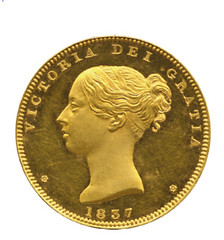 Finally, lot 33, an extremely rare Victoria small bust pattern Sovereign of 1837 sold for £28,800. The coin is considered to be the first proposed pattern Sovereign for the young Queen Victoria for which she granted engraver, William Wyon, multiple portrait sittings. The head is of a small stature, the rear hair fillet lightly ruled with horizontal lines and the legend closely spaced; the reverse by Jean Baptiste Merlen being very similar to that adopted for currency. The piece is very light in weight so that it would not go very far should it escape into circulation. The coin sold well over its initial estimate of £15,000 - 20,000.
Finally, lot 33, an extremely rare Victoria small bust pattern Sovereign of 1837 sold for £28,800. The coin is considered to be the first proposed pattern Sovereign for the young Queen Victoria for which she granted engraver, William Wyon, multiple portrait sittings. The head is of a small stature, the rear hair fillet lightly ruled with horizontal lines and the legend closely spaced; the reverse by Jean Baptiste Merlen being very similar to that adopted for currency. The piece is very light in weight so that it would not go very far should it escape into circulation. The coin sold well over its initial estimate of £15,000 - 20,000.
Parts two and three of the Bentley Collection are due to be sold on the 27th September 2012 and the beginning of May 2013. The collection, in its entirety, is estimated to achieve around £3,000,000 and the decision to divide the collection in to three parts has been carefully considered to allow Sovereign collectors time to plan their proposed purchases properly.
For more information, see: www.baldwin.co.uk/bentley
To read the earlier E-Sylum article, see: THE BENTLEY COLLECTION OF BRITISH GOLD SOVEREIGNS (www.coinbooks.org/esylum_v15n13a12.html)
FROM TEXAS TO THE MOON WITH JOHN LEONARD RIDDELL
The Capital City Coin Club of Austin, Texas, enjoyed a "Quiz Bowl" for our May 3, 2012, meeting. Knowing that John Leonard Riddell of the New Orleans Mint also carried out a botanical survey expedition of Texas, I intended to put a question about him in the stack. That led me to the archives here at The E-Sylum. Searching Google Scholar, JSTOR, the ANA, the ANS, and other databases provided over 70 bibliographic citations, most of them from botanists for whom Riddell's work in Ohio but also in Louisiana is still relevant. Among the many compelling facets of his life is his being credited as the first scientist to write a science fiction story.
John Leonard Riddell published his own science fiction story Orrin Lindsay's Plan of Aerial Navigation, with a Narrative of His Explorations of the Higher Regions of the Atmosphere, and His Wonderful Voyage Round the Moon in 1847. He also delivered the account as lecture to the People's Lyceum of New Orleans.
Among the treasures I gathered while hopping through cyberspace was a PDF of Riddell's Memoir on the Nature of Miasm and Contagion (1836), in which he posited a germ theory for disease. He later advocated for this theory when serving on a blue-ribbon panel to study the typhoid epidemic of New Orleans, 1853-1854.
A Selected Bibliography for John Leonard Riddell.
Armstrong, Clara. "Plant Names Commemorative of Ohio Botanists," Ohio Naturalist. Vol. 1, No. 3 Jan, 1901.
Bailey, L. H., "Some North American Botanists. VIII. John Leonard Riddell", Botanical Gazette, Vol. 8, No. 8 (Aug., 1883), pp. 269-271.
Bleiler, Everett F. "John Leonard Riddell, Pioneer, " Science Fiction Studies Vol. 36, No. 2 (July 2009), pp. 284-299.
Breeden, James O. "A Long Ride in Texas: the Explorations of John Leonard Riddell". College Station: Texas A & M Press, 1994.
Dexter, Ralph W. "The Early Career of John L. Riddell as a Science Lecturer in the 19th Century, " Ohio Journal of Science 88 (5) 1988: pp. 184-188.
Dorr, Laurence J., "The Identity of Riddelia Raf. and Remarks on Corchorus L. (Tiliaceae), " Taxon, Vol. 41, No. 1 (Feb., 1992), pp. 80-83.
Ewan, Joseph. "Historical Problems for the Working Taxonomist", Taxon, Vol. 18, No. 2, Smithsonian Summer Institute in Systematics 1968, Part 2(Apr., 1969), pp. 194-203.
Lambousy, Greg. "Riddell's plan for the melting room at the New Orleans Mint",Gobrecht Journal Vol. 31, no. 91 (November 2004).
Lambousy, Greg , "The mint at New Orleans: with an account of the process of coinage. by Riddell, J. L, " Numismatist Vol. 81, no. 4 (April, 1968).
Lowden, Richard M. " Riddell, Sullivant, and the Early Botanical Exploration of Franklin County, Ohio, U.S.A. (1832-1840), " Taxon, Vol. 46, No. 4 (Nov., 1997), pp. 689-703.
Schwarz, Ted. "The paper money of John Riddell," Coins, Vol. 24, no. 8 (Aug., 1977).
Walp, Russell Lee, "Riddell's Notice of Vegetable Productions Growing Spontaneously in Washington County, Ohio," The Ohio Journal of Science 51(6): 320, November, 1951.
Wilbur, Robert L. and Margaret K. Whitson, "The Identity of Riddell's Seven Validly Published but Over-looked Pteridophytic Binomials" American Fern Journal, Oct 2005 95(4), pp. 160-170.
Wilbur, Robert L. and Maggie K. Whitson. "Taxonomic Assessment of the North American Taxa Published by John L. Riddell in 1853," Rhodora, 109:938, (2007) pp. 161-186.
Winter, Douglas. Gold Coins of the New Orleans Mint: 1839-1909. Irvine: Zyrus, 1992, 2006.
QUICK QUIZ: WHAT DOES N.I.T. ON BRYAN MONEY STAND FOR?
Michael Sanders of Beaverton, OR writes:
OK, I should definitely know this. Can someone tell me what the initials "NIT" found on numerous pieces of Bryan Money refer to? A search of Schornstein's book did not yield an answer as far as I can find. Thanks in advance.
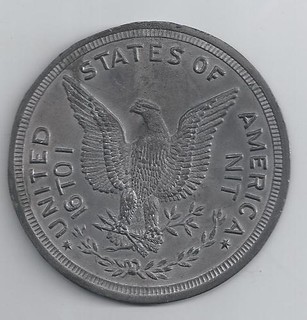
QUERY: WHO IS THAT GENT WITH LINCOLN AND GRANT?
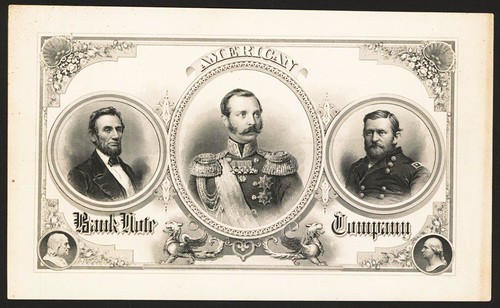
Kerry Rodgers of Auckland, New Zealand writes:
This American Bank Note Company advertising item sold for $1,652 in Archives International Auction XI held in May. It shows Lincoln and Grant flanking a gentleman. The catalog believes him to be a Russian and the item to date from the1860s. Can any reader provide an identification?
BOOK LEADS COLLECTOR TO RARE 1983 COPPER-ALLOY CENT
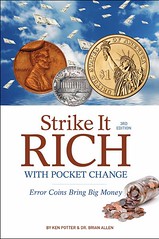 A 1983 copper-alloy cent has been found by a Pennsylvania collector who had purchased a copy of Strike it Rich with Pocket Change that was co-authored by Dr. Brian Allen and me.
A 1983 copper-alloy cent has been found by a Pennsylvania collector who had purchased a copy of Strike it Rich with Pocket Change that was co-authored by Dr. Brian Allen and me.
It is the second one known to exist. All cents made in 1983 should be of copper-coated zinc.
The collector, who wishes to remain anonymous, made her discovery several weeks after acquiring the book.
She reports that she found the copper cent after reading our account of how Billy Crawford of South Carolina found one by setting all the 1983 cents to the side, while looking for doubled dies and other varieties in circulated rolls, so that he could weigh them all later.
The cents struck from 1963 through about mid 1982 are of a solid brass composition made up of 95 percent copper and 5 percent zinc. They weigh 3.11 grams. The cents struck from about mid 1982 to date are struck on planchets made up of a solid zinc core (with a trace of copper) that are barrel plated with pure copper and weigh 2.5 grams.
 Crawford hoped that his efforts would result in him finding a transitional error of a 1983 cent struck on a planchet left over from the early part of 1982 before the copper plated zinc cents were introduced later in that same year. Eventually he found one and we detailed his story on the find on Page 64 of the second edition and on Page 75 in the third edition of our book.
Crawford hoped that his efforts would result in him finding a transitional error of a 1983 cent struck on a planchet left over from the early part of 1982 before the copper plated zinc cents were introduced later in that same year. Eventually he found one and we detailed his story on the find on Page 64 of the second edition and on Page 75 in the third edition of our book.
In our book we placed a possible value of $15,000 on an AU/Unc. example but it was just a guess. The owner now has this coin slated for sale in an upcoming Heritage auction, so we'll see how this one goes and report on the result.
To read the complete article, see: Book spurs rare cent find (www.numismaticnews.net/article/book-spurs-rare-cent-find)
ARTICLE CLAIMS 1870-S THREE DOLLAR GOLD PIECE FOUND IN A BOOK
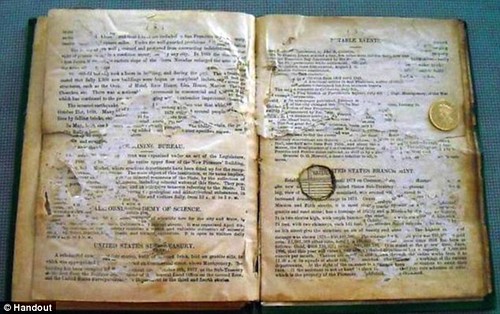
 A $3 gold coin is expected to fetch $4 million when it goes up for auction next month.
The 1870-S is one of just two ever made and is one of the rarest coins in US history.
It was discovered in a San Francisco bookshop in 1997 by a European tourist, who found it glued to the inside pages of a souvenir book.
A $3 gold coin is expected to fetch $4 million when it goes up for auction next month.
The 1870-S is one of just two ever made and is one of the rarest coins in US history.
It was discovered in a San Francisco bookshop in 1997 by a European tourist, who found it glued to the inside pages of a souvenir book.
The collector sat on his unbelievable find for 15 years, before bringing it to auction at the Four Seasons Auction Gallery outside Atlanta, Georgia.
The coin was produced by the San Francisco mint on special order of the mint superintendent, originally meant to be placed in the cornerstone of a building in the city. It was made from a special cast that had a unique 'S' hand-carved into it. The 'S' is what makes the coin so rare.
When the coin in the cornerstone was damaged and removed, a second copy was cast. That duplicate is on display at the American Numismatic Association Museum in Colorado Springs, Colorado. In 2007, it was valued at $4 million.
Appraisers aren't certain of the origin of the coin that is going on the auction block next month. It could be the original that was taken from the cornerstone of the building. Or, it could be a third copy that was made and never reported.
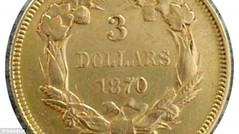 Does anyone recognize the book? Is it a tourist guide? The article calls it "a souvenir book".
Nice souvenir. Great story. But does this yarn pass the smell test? Why would a European seller end up consigning a coin like this to U.S. estate auctioneer where it would be sold alongside furniture, cars and baseball cards? And why is the photo of the coin cropped so you can't see the "hand-carved" mint mark that is key to the coin's value?
-Editor
Does anyone recognize the book? Is it a tourist guide? The article calls it "a souvenir book".
Nice souvenir. Great story. But does this yarn pass the smell test? Why would a European seller end up consigning a coin like this to U.S. estate auctioneer where it would be sold alongside furniture, cars and baseball cards? And why is the photo of the coin cropped so you can't see the "hand-carved" mint mark that is key to the coin's value?
-Editor
To read the complete article, see:
Rare $3 gold coin worth $4 MILLION goes on auction... and it was discovered in an old book
(www.dailymail.co.uk/news/article-2145652/Rare-3-gold-coin
-worth-4-MILLION-goes-auction--was-discovered-old-book.html)
Since I wrote this earlier this week I discovered I'm not the only one questioning this. Dave Harper wrote:
Nowhere in the press information does the auction gallery mention that the coin has been submitted to any experts for authentication and grading.
No PCGS. No NGC. No ANACS. No ICG. There is not even mention of an off-brand XYZ holder.
Instead we are told by the auction house that an unidentified European tourist found it in 1997 in a San Francisco bookstore glued to an inside page of a souvenir book on which appears a story about the San Francisco Mint.
Also, the coin is not currently available for examination. The firm says the coin is insured by Lloyd's of London and will be brought by armed guards from a bank vault to Four Seasons Auction Gallery on June 2 where the coin can be "previewed" only on auction day from 9:30 a.m. to 11 a.m. under armed guard.
After that 90-minute period I guess buyers will be expected to bid for the coin.
I can't help but ask myself that if some unknown discoverer of a supposedly incredibly rare coin or his agent can find Lloyd's of London, he or she could also find Heritage, Stack's Bowers or another prominent American numismatic firm that would submit the coin to all the rigorous examination and testing that these auction houses would insist on before challenging the unique status of the Harry W. Bass Jr. Foundation's 1870-S $3 gold piece housed at the American Numismatic Association's museum in Colorado Springs, Colo.
To read the complete article, see: Like a $3 bill? (www.numismaticnews.net/buzz/like-a-3-bill)
An update from CoinWeek says the item has been removed from auction. It does have a full image of the reverse of coin offered for sale. No one can say for sure if this coins is or isn't what the sellers purport it to be. I would be happy to learn the story is true, for that would make for an interesting new chapter in U.S. numismatic history.
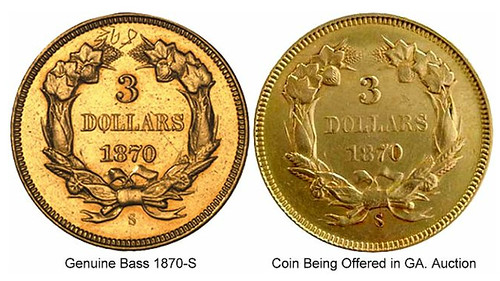
To read the complete article, see:
The Coin Analyst: Extremely Rare 1870-S $3 Gold Coin To Be Auctioned on June 2 in Georgia - Real or Fake?
(www.coinweek.com/news/featured-news/the-coin-analyst-extremely
-rare-1870-s-3-gold-coin-to-be-auctioned-on-june-2-in-georgia-real-or-fake/)
THE BOOK BAZARRE
ANNOYING AUCTION HOUSE SALE TERMS
I bid on and won a lot that piqued my interest this week. It was not in the numismatic field, instead it was in the art field. Amidst hundreds of paintings and sculptures, was a handful of reliefs of numismatic interest. The auction rules were so stringent that made sure you really wanted to bid on a particular lot -- and that you would pay for it promptly.
Please, if you are an executive of a numismatic auction firm do not read any further. I sincerely hope these conditions and higher buyers fees are not adopted in the numismatic field. Perhaps coin auction houses are aware of the conditions in other fields, but this was my first exposure to how some art auction houses are tightening the screws.
Not everyone reads the auction rules in front of the catalog or itemized on an internet auction. These should be read before every new auction. In effect, the auction house is declaring: "These are the conditions in which you can bid on our lots; if you don't like it, don't bid."
I ordered the catalog by phone and had to give my credit card number. The buyers fee in this auction is 25%. If you attend in person the buyers fee is 26% (plus the states sales tax). That discouraged attending in person and bidding from the floor.
I elected to bid by phone. I called again to register. They required my credit card number again. You have that already I said. "Sorry, that's another department. We don't pass around credit card numbers." Obviously they needed your phone number and first lot you wish to bid on.
A pleasant-voice clerk called five lots before the one I want to bid on, while the auction was being called. I asked how she preferred to learn of my advance. We agreed "bid' was satisfactory.
My lot was estimated at $1800 to $2000. It opened at half the low estimate. That told me they had no mail bids. "Bid" I said. I could hear the auctioneer state my bid, "$1,000."
Over $1,000 the increments increased. "$1,200." That is a floor bid said Lovely-Voice. "Bid" I said. I heard the auctioneer announce $1,400." He repeated it and no further bids. I had won the lot. Mr. Floor Bidder -- if he did exist -- had dropped out.
I was happy to obtain the lot at $1400. My preset limit was $2200. So I was well ahead and obviously delighted. Had I submitted a $2200 mail bid, I wondered in my mind where the lot would have opened, and what it would have been knocked down at.
Two days later the invoice arrived. The two credit card numbers given previously were not needed. They preferred wire transfer or personal check. But checks were to be made out to a name different from the name of the auction house.
To encourage prompt payment the invoice stated the buyers fee would have a 3% discount if paid in ten days. I calculated the fee at 22% instead of 25%.and added that to the $1400 hammer price. Then wrote the check.
The auction house does not do the shipping. I had to sign a form authorizing a different firm to package and ship the material. Here again a request for a credit card number. When that invoice arrives I wonder it that charge will indeed go on the credit card this time, or another request for personal check.
QUERY: SUTLER PAPER MONEY CATALOG SCHEME
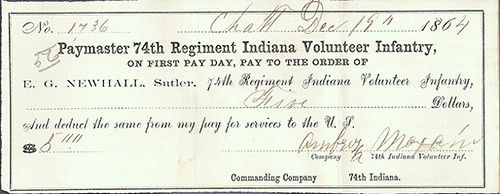
I recently purchased Kenneth Keller's out of print book "Sutler Paper Money" published by Rich Hartzog. I listed Sutler scrip associated with Tennessee in the Tennessee Obsolete Book I am developing. I was able to identify the TN-related Sutler I had images that were in the book. However, a number of the pieces I have images of are not listed in the book. I wish to extend the identification system to include the pieces that are not listed for the new finds. Has anyone extended the book listing to add new finds?
For example the note 74th Regiment IN, E.G. Newhall Sutler $5 should probably be identified as IN-SE500 (Last letter in IN section of the book is IN-SD). It should be between 67th Regiment IN (IN-SB050) and 79th Regiment IN (IN-SC025).
I also have a $2 similar image from same Regiment and same Sutler so it should be IN-SE200
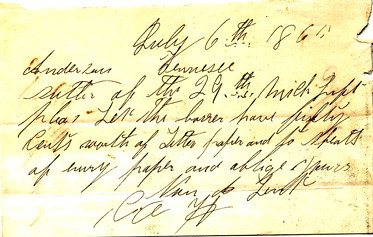
A more difficult one is the handwritten 29th Michigan Infantry $0.50 note This appears to be similar to the $5 MI-PE-A listed in the book.
I am not sure of the difference between the Paymaster (P) notes and the other notes (S) listed in the book. If anyone can help, I would appreciate it.
QUERY: HOW TO PUBLISH A NUMISMATIC BOOK IN 2012
I am enjoying the conversation about paper vs. electronic books, especially because my book on Centennial medals is facing a critical go/no-go milestone: will it be paper or electronic? The mainstream numismatic paper publishers have already informed me some time ago, politely but firmly, that they cannot afford to publish such a large book, all in color, that will cater to such a small predicted segment of the numismatic collecting frarority (there are female collectors, too), but they acknowledged the need for such a book and wished me "great success in my worthy endeavor."
It was Dave Schenkman who first suggested that I put my book online. His rationale, aptly illustrated with his own authoring experiences, was compelling. As a result, though the book is not yet ready for public prime time, I have developed a stand-alone website that presents the book, chapter by chapter, in pdf format, which allows full word search, enlargement of photos to full-screen size, printing, and downloading at no cost to readers.
Since I would not expect to make a profit on a self-published paper book, I can actually save money by giving the book away, and I see many other advantages, among which are:
- There is very little up-front cost (about $31) to be fully "published."
- The maintenance costs are very low (about $7 per month).
- Volunteer editors and proofreaders can easily access the book when it first goes online only to selected persons.
- We can correct errors and omissions as they are discovered, even after going "public," without having to wait who knows how long before a subsequent paper edition might be justified.
- I can Immediately add previously unknown medals (at least to me) as they are brought to my attention by fellow collectors. (I hope there are many!)
- I can include a forum feature that will facilitate discussion and collaboration among fellow collectors.
- The zero cost to readers and open collaboration among fellow collectors should result in greater "distribution" than would trying to flog a $200+ paper book.
I would appreciate any and all comments, suggestions, and criticisms before I take the irreversible step of actually going public.
To read the earlier E-Sylum article, see: MORE ON ELECTRONIC BOOKS (www.coinbooks.org/esylum_v15n20a09.html)
BRITISH NUMISMATIC JOURNAL AVAILABLE ONLINE
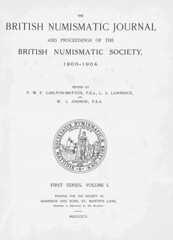 The Society has recently made a complete digital archive of all issues of the BNJ to 2007 freely available to download. New and recent volumes will be made available five years after publication. Below is a list of volumes arranged chronologically. If you are looking for a specific subject then you can consult the Index of BNJ contents 1903-2010. This is a concise index of the contents of all material up to 2010, arranged thematically.
The Society has recently made a complete digital archive of all issues of the BNJ to 2007 freely available to download. New and recent volumes will be made available five years after publication. Below is a list of volumes arranged chronologically. If you are looking for a specific subject then you can consult the Index of BNJ contents 1903-2010. This is a concise index of the contents of all material up to 2010, arranged thematically.
These files are in PDF format and can be read using Adobe Acrobat Reader which is freely available to download here. The files are quite large (most are over 100mb) and thus may take some time to download. You can click the link and read the volume in your browser but if you wish to download the file you will need to right-click and select 'save as'.
This project has only recently been completed and it is possible there may be some problems. If you encounter anything unexpected please contact the BNS Webmasters.
To access the digital British Numismatic Journal, see: British Numismatic Journal (www.britnumsoc.org/publications/bnj.shtml)
MORE NUMISMATIC BOOKS ON CD/DVD
I looked around on eBay and found quite a few numismatic books and book collections. This list is just the highlights. These items can be found by signing in to your eBay account, going to ADVANCED SEARCH, then click BY SELLER in the left box. Type in the name of the seller you want to see.
EBay seller: ebookcoins_2009 (located in Israel)
Most of these CD's are $9.99 starting bid or $12 Buy It Now. $7 shipping
- Numismatic Chronicle (Royal Numis. Society) 100 volumes 1838-1940
- Revue Numismatique (France) 75 volumes 1836-1908
- Ancient & Medieval India Coins 130 books
- Greek & Roman Coins 160 books
- Islamic Coins 165 books
- Byzantine, Parthian & Sassanian Coins 70 books
- Islamic, Byzantine, Parthia, Sassania 365 books $25 start / $29.99 Buy It Now
* * * * * *
EBay seller: mirmidonas55 (located in Greece)
- Revue Numismatique Belge 58 volumes 1845-1924 start price $7.78
- Numismatic Chronicle (RNS) 67 volumes 1837-1917 start $12
- Celtic, Early USA, Greek, Roman & Jewish 117 books (mostly in English) start $15
- Belgian, Dutch & Luxembourg coins 100 books (all in French or Dutch) start $15
- Illustrated History of Coins & Medals Relating to Canada (1894) by Breton start $1.00
- Encyclopedia of Coins of Malaysia, Singapore & Brunei 1400-1967 by Singh start $1.00
* * * * * *
EBay seller: informationdvd (located in Riverside, CA)
- Greek coins 30 books $6.75
- Roman coins 20 books $6.75
- Poor's Manual of Railroads 22 volumes 1880-1902 $6.75 (each is a very thick, annual publication on RR in USA and Canada) many state and county history collections starting at $3.75
** * * * * * *
EBay seller: kenlaszlo579
Jewish coins and history 22 books start $7.75
* * * * * * *
EBay seller: collectionsandartifacts (located in Philippines)
China & Japan coins 21 books
(this is the same collection of 20 books sold by another seller, plus Saran Singh's Encyclopedia of Coins of Malaysia & Brunei -- a great book)
* * * * * *
EBay seller: magc66 (located in England)
- China & Japan coins 20 books start $5.65
- Italy coins 100 books plus an Italian numis. journal 1888-1921
- French coinage 109 books
- Russian & Eastern Europe coins 23 books
- Greek history and coins 234 books
- Islamic coins 80 books
- German & Austrian coins 119 books
- British coins and tokens 171 books
- Spanish & Portuguese coins 53 books
- USA, Canada & Mexico coins & history 104 books (including 23 volume Canada history)
- Greek & Roman coins 289 books -- many great works including Frey (Numismatic Names);
- Wroth (Byzantine Coins 2 vol.); Sabatier (Byzantine Coins 2 vol.);
- Head (Greek Coins 2 vol.);
- Cohen (Roman Coins 1860 - 8 volumes);
- Greek Coins in British Museum (18 volumes!);
- Mionnett (1819 - 9 volumes);
- Eckhel (Roman Coins 1792 - 8 volumes); and
- Journal International D'Archeologie Numismatique - 8 volumes 1900-1910. start $8.89
At these prices, it's worth buying these CD's even if you don't collect those areas. There are probably other similar CD's on Amazon or elsewhere. There are also many CD collections of works on history. Oh, yes, some of these are DVD. I presume DVD's will play on any recent computer, though the sellers say you may need to download some free software.
To read the earlier E-Sylum article, see: MORE ON ELECTRONIC BOOKS (www.coinbooks.org/esylum_v15n20a09.html)
HARVEY STACK ON THE ADAMS FAMILY COIN COLLECTION
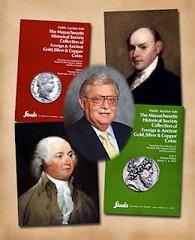 Few know that the Adams family had a coin collection. The Adams family coin collection began with the acquisitions of John Adams. He represented Massachusetts at the Continental Congress, from which came the Declaration of Independence and the forming of the United States. He was later sent to Europe to solicit aid and finances from France to help the new nation establish itself. While in Europe, because of his interest in coins, he and his son John Quincy Adams (who became the sixth president of the U.S.) assembled coins as they related to history, from the time of Greek and Roman civilizations up to the time they lived in.
Few know that the Adams family had a coin collection. The Adams family coin collection began with the acquisitions of John Adams. He represented Massachusetts at the Continental Congress, from which came the Declaration of Independence and the forming of the United States. He was later sent to Europe to solicit aid and finances from France to help the new nation establish itself. While in Europe, because of his interest in coins, he and his son John Quincy Adams (who became the sixth president of the U.S.) assembled coins as they related to history, from the time of Greek and Roman civilizations up to the time they lived in.
The entire Adams family was quite literate, each having had a Harvard education. Their letters to each other, diaries, and other documents reflected details of the times they lived in and are cherished as historical treasures today.
In the early 1970s it became obvious to the Massachusetts Historical Society (MHS) that the great historical documents, letters, papers and memorabilia of John Adams and his family, which were stored at the Society, were slowly deteriorating and yet, were not fully available to scholars. Something had to be done to preserve them. However, funds were not available for this mammoth project.
The numismatic items from the Adams family were first stored at the MHS, and were never fully inventoried or studied. In the 1950s the collection was moved to the Museum of Fine Arts in Boston (MFA) to be reviewed and evaluated. Because of its size, this job was worked on slowly. As funds and people were not available to do this, the collection was not fully cataloged or available and selling it was considered as an option.
Under the supervision of Cornelius Vermeule, the numismatic curator at MFA and later director of the museum, with the assistance of Mary Comstock of the museum staff, the collection of coins, medals and other numismatic material was cataloged. After the work was done, it was suggested that the collection be sold at public auction in order to provide the funds to properly microfilm and preserve the entire document collection.
Stack's, with our vast experience in dealing with numismatic treasure held by museums and educational institutions, was selected to sell the coins from the Adams Family collection, and held by the Massachusetts Historical Society.
An interest story is that of when my cousin Norman Stack and I went to Boston to pack up the collection for shipment to New York. The coins and medals were housed in large wooden cabinets, each having some 60 trays to hold the coins. To secure the collection, these cabinets were housed in large storage vaults in the Museum of Fine Arts. The walls of the vault were lined with huge display cabinets, some 12 feet high, each containing a quantity of ancient Greek and Roman heads (from statues).
There must have been a thousand or more. All seemed to be looking down at Norman and me. All those "watchful eyes" seemed to provide the security for the collection. As there was no table to use for packing, Dr. Vermeule suggested we use the large wooden case in the center of the floor. We asked what was in the case and he told us it was an Egyptian sarcophagus, intact, which the museum hadn't had time to unpack! We remarked, "We guess that's another pair of eyes watching the collection!"
After the collection arrived in New York, Stack's prepared a series of catalogs in 1971 and 1973 which offered these numismatic treasures for sale at auction. We were fortunate in obtaining a few Photostats of a small inventory of the collection, together with a drawing as how the coins were kept in the trays of the cabinets. All were done originally by the Adams family.
The funds acquired from the sales were used by the Massachusetts Historical Society to photograph and microfilm the Adams papers for the permanent record. It is interesting to learn from the HBO programs, that if one were to take the microfilms of all the papers, the film could stretch for 25 miles. Hence, great history was recorded!
To read the complete article, see: Remember When: How Stack's Helped Save The Famous Adams Family Papers (stacksbowers.com/Blogs/remember-when-how-stacks-helped-save.html)
AN INTERVIEW WITH DR ANDREW BURNETT OF THE BRITISH MUSEUM

Dr Andrew Burnett, Deputy Director of the British Museum, was awarded a CBE in the Queen's New Years Honours list. In an interview with the Newsletter Andrew talks about how he came into numismatics, his work at the British Museum and the future of the subject.
Where did your interest in coinage stem from?
My interest in coins began in what nowadays would be called a gap year. For a few months I spent time in Italy, as a general slave at the British School at Rome. While I was there I met Richard Reece who was en route to Malta to work with the British Council to help sort out their coin collection. He kindly asked me if I would like to go along. I did and that's how I became interested. As I later learnt, this was a characteristic bit of Richard's generosity - he got so many people interested in the subject, and I have always admired him as my inspiration. Once you have been bitten by the coin bug, though, I think there is little hope of escape.
How did you come to work at the British Museum?
After I had graduated I was uncertain, like so many people, about the next move. While I was dithering in this way, I saw a job advertised at the BM, and applied for it. Rather to my
surprise I was offered it, and here I am still!
How has the museum changed since you've been there?
An impossible question! The main changes are that the visiting public has grown enormously, both in person and more recently, with the digital revolution, electronically. These changes have transformed and are transforming what we do. Government funding has also declined greatly, but I am impressed how the institution has risen to the challenge. I would also stress what hasn't changed - a commitment to academic excellence and to sharing the collection and our knowledge as widely as we can.
On being awarded the CBE
Well, it's all a bit embarrassing to get it, as it really depends on all the efforts of many other people, both at and outside the museum. I see it as a nice recognition of what the museum is achieving and the importance of numismatics to that achievement. It is a real surprise when you get a letter asking if you will accept an honour - you get it about a month before the announcement.
I think everyone goes through a bit of agonising over whether or not to accept, but in the end most of us do it for our mothers, I think! Then you get summoned to the Palace and there is an Investiture, sometimes with the Queen but in my case the Prince of Wales. You are called forward; he puts the badge with its ribbon over your neck, and then says a few words (we talked about collecting and research); then you take a couple of steps backwards, bow again, and leave his presence. It's quite nerve wracking - reminded me of giving my first talk at the RNS...
To access the Money & Medals newsletter archive, see: www.moneyandmedals.org.uk/#/newsletter/4547094513
WAYNE'S NUMISMATIC DIARY: MAY 20, 2012
I ran out of time to write my diary last week, so I'm picking up where I left off. My meeting of Nummis Nova was a hoot - we have a great time telling jokes, talking trash, and passing around some really interesting numismatic items.
Wayne Herndon had just been at the Early American Coppers show, and told me that two different people had come up to his table saying they were excited to finally meet him in person - then he found out they thought he was me. I guess there are too many Wayne H's from Virginia in numismatics. He's the one with the cool mustache. NOTE TO READERS: my stock head shot is getting a little dated, but it has no mustache and I haven't grown one.
Speaking of mustaches, our old pal Bill Eckberg attended the meeting for the first time WITHOUT his mustache. I hadn't seen him for a while - he retired and he and his wife Susan sold their house and headed south to Florida, where they've been waiting to close on a new place. He was back in town for a visit, looking tanned and rested. I knew he looked different, but it took me a few minutes to realize the 'stach was gone. It was great to have him back.
Another person we hadn't seen for a while was Dick Doty, Curator of the National Numismatic Collection at the Smithsonian. He brought with him a very interesting coin from his personal collection, a junk box purchase from a coin show.
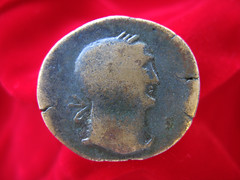
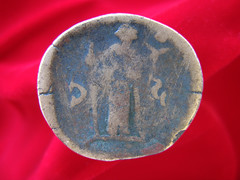
Dick writes:
About ten, fifteen years ago, at the Vienna show, I was rooting thru one of Don Zauche's junk boxes, the $20 one, when I came across this weird-looking "Roman" coin, an obvious copy. It interested me, but not enough to fork over twenty bucks, so I gave it a pass. But I thought about it off and on, and at the next show, it was still there, and I bought it then and there.
It's a copy of a sestertius of Trajan, likely made around 150 AD, I'd hunch by one of the Germanic tribes outside the Empire. The interesting thing is that whoever was doing the dies was copying direct from an actual coin, so he got everything backwards - right down to the SC. But you can't blame a guy for trying.
It appears to be a copy of RIC Vol.2 (Vespasian to Hadrian), Trajan 488, an undated sestertius minted at Rome between 103 and 111. The original types are emperor's head left, laureate, with aegis/Roma standing left, holding Victory and spear, kneeling Dacian at her feet. The Dacian got left out of the copy. This may have been a deliberate omission.
QUICK QUIZ: Eric Schena brought along two obsolete banknotes, one genuine and one a contemporary counterfeit. He challenged us to pick the fake. I got it right. Is it the one on top or the bottom? Why - what are the telltale signs? To see larger images, click on the photos to go to our Flickr archive.


I used my copy of an old Thompson's Counterfeit Detector to confirm it was a counterfeit. Great how a 160 year old counterfeit detector still works. Here's the entry for the Farmers Bank of Virginia - see if you can spot the specific listing that I used.
Dave Schenkman's error show-and-tell item was a double denomination coal scrip token - $5.00 on one side, $1.00 on the other. I joked that the company showed the $5.00 side on payday, and the $1.00 side at the company store.

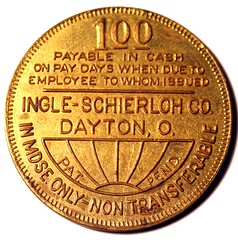
Dave writes:
Unlike the majority of trade tokens, which have the denomination on either the obverse or reverse, tokens struck by "system scrip" companies have it on both sides. This is because the issuing merchant's name, etc., and the denomination is on the obverse, and the reverse is usually a "stock" die which has the manufacturer's name, etc., and also the denomination. The Ingle Schierloh Company used different size planchets for each denomination, except for the $1.00, $5.00, and $10.00 tokens which were usually all on 35mm planchets.
This double denomination occurred because the employee striking it took the five dollar obverse die cut for the Cambria Coal Company and instead of taking a matching five dollar "stock" reverse die, grabbed a one dollar die. An error such as this could happen with any combination of $1.00, $5.00, and $10.00 tokens. It couldn't happen on tokens under a dollar, since each denomination was a different size.
I am aware of five different double denomination Ingle Schierloh Company tokens, and with one exception, each is unique. I imagine errors of this sort were either detected before the tokens were shipped, and destroyed, or were returned by the company that ordered them.
Dave brought some token dies as well as a rare token struck from one of them. Thanks for the images!
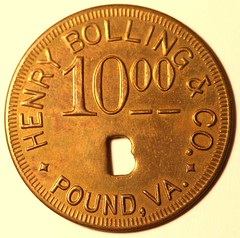
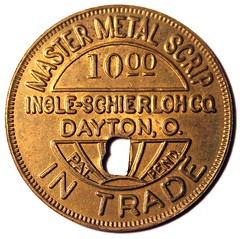
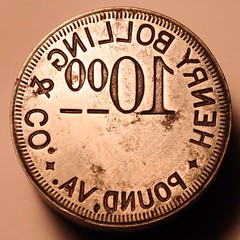 Henry Bolling operated a general store in the tiny town of Pound, Virginia. In June, 1929 he ordered "Master Metal Scrip" tokens in 1c, 5c, 10c, 25c, 50c, $1.00, $5.00, and $10.00 denominations from the Ingle Schierloh Company of Dayton, Ohio. Mintages ranged from 200 to 500 pieces, except for the $10.00, which had a mintage of only 100.
Henry Bolling operated a general store in the tiny town of Pound, Virginia. In June, 1929 he ordered "Master Metal Scrip" tokens in 1c, 5c, 10c, 25c, 50c, $1.00, $5.00, and $10.00 denominations from the Ingle Schierloh Company of Dayton, Ohio. Mintages ranged from 200 to 500 pieces, except for the $10.00, which had a mintage of only 100.
I acquired my $10.00 token in the 1970s, and also the obverse die used to strike it. To the best of my knowledge no other example of the token has surfaced.
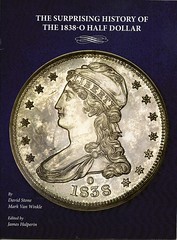 Later this week I received in the mail a copy of a new monograph by David Stone and Mark Van Winkle about the 1838-O half dollar. I hope to have more information about this title next week.
Later this week I received in the mail a copy of a new monograph by David Stone and Mark Van Winkle about the 1838-O half dollar. I hope to have more information about this title next week.
RENOVATIONS AT THE OLD SAN FRANCISCO MINT
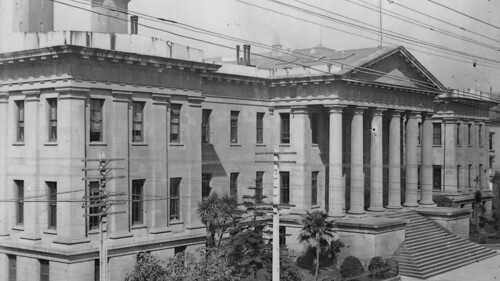
New architecture is great, but in some cases people in the 19th century had things figured out just fine. Sometimes the best way to make a building cutting edge is to go back to the original design.
The Mint--one of the few large buildings to survive the 1906 earthquake--generated coins until 1937. In 2003, the federal government sold it to the city of San Francisco to turn into a museum (the Museum of the City of San Francisco). That's where architecture firm HOK came in.
"The Mint is this 19th century historic building that had a lot of unfortunate contemporary renovation done in the 1960s and 1970s. Our team peeled off these layers to find the old Mint and the old systems," explains Zorana Bosnic, Sustainable Design Director at HOK. "Although as a genre steampunk is better understood in design, art, literature, and movies, if you think about it, it's about celebrating the innovation of the 19th century that's deeply rooted in that kind of technology."
Case in point: After removing the old layers of the building, the HOK team discovered that the Mint had five foot thick walls and basically was a giant thermal mass, making it naturally heat efficient. The Mint was also entirely reliant on natural ventilation. "If you think of the kind of industrial conditions in the Mint and how that system functioned then, surely we can find ways for that to be a prevailing system now," says Bosnic.
But of course, years of thinking that new is always better made some of the Mint's features difficult to restore. The windows that helped provide natural ventilation were all sealed, and at some point a dropped ceiling was installed. "You would walk into spaces and feel like it's any other office building with a dark, dropped ceiling. A lot of that that had to be taken out in order to try and restore it," says Bosnic.
There's one 19th-century leftover from the Mint that was perfectly intact: the building itself (something of a rarity post-1906 earthquake). The bottom slab of the building was made with a well-reinforced mat-slab foundation. There's also a trench around the structure--the thinking being that in a seismic event, you have to allow the entire building to move to preserve it.
That's exactly what happened in the 1906 earthquake. Everything around the building was destroyed, and legend says that the entire Mint moved by two feet without causing any damage. "Those are the things where you get excited. It's the 19th century and they already thought of what we now know as the base isolation system which is now done with steel and a lot more technology," says Bosnic. "It's really important to rediscover that type of resilience."
The Mint is still under renovation. No word yet on an opening date for the museum.
To read the complete article, see:
Steampunking An Old Building To Make It More Efficient
(www.fastcoexist.com/1679836/steampunking-an-old-building
-to-make-it-more-efficient)
SAN FRANCISCO MINT CELEBRATES 75TH ANNIVERSARY
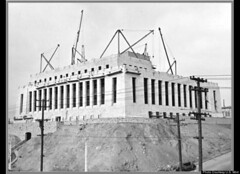 The old San Francisco Mint's replacement, the "new" (and current) San Francisco Mint is getting a little long in the tooth herself, celebrating her 75th anniversary this year. Here's a group of photos taken during construction.
-Editor
The old San Francisco Mint's replacement, the "new" (and current) San Francisco Mint is getting a little long in the tooth herself, celebrating her 75th anniversary this year. Here's a group of photos taken during construction.
-Editor
To read the complete article, see: (www.huffingtonpost.com/2012/05/15/san-francisco-mint-75th-anniversary_n_1519121.html)

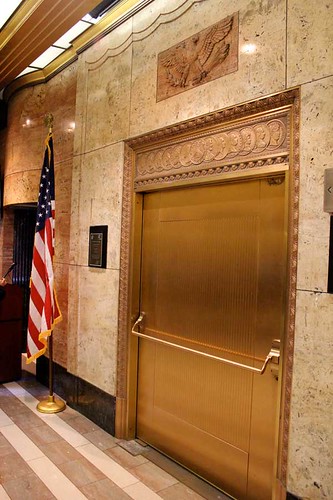
Officers raided a makeshift factory where it is alleged crooks were churning out up to 1,000 counterfeit coins a
day.
Cops suspect the forgers were planning to circulate the fakes during the Olympics - when the capital will welcome
millions of extra visitors.
City of London Police found a smelting machine, ingots of metal and moulds for £2 and £1 coins in a
rented room in an office block. Just 300 yards away, officers also raided a scrapyard hidden behind a wall of tyres
where the coins were coloured with gold spray paint.
A total of £2,000 in finished fakes was seized in Canning Town, East London. Three suspects were arrested.
Det Chief Insp Dave Evans, who led the operation, said: "With the set-up they had they could keep producing
at a very steady rate - it's just a matter of putting in the hours.
"Time literally was money in this case. The coins look like the real thing at a glance and they will have got
the weight more or less spot-on through trial and error.
"It really is a cottage industry. The electricity voltage needed to run the machines is no more than to boil a
kettle. It won't have made much noise and could have been done around the clock."
It took just minutes at a time to make 12 coins which were then sprayed gold. Commander Ian Dyson, of City of London
Police, said: "We know criminals have targeted £1 coins. What we've not seen so much of is criminals trying to
make £2 coins - probably because they're more difficult to produce.
Experts say fake £1 coins can seem more shiny and the lettering on the edge may be uneven.
To read the complete article, see:
Counterfeit coin con cracked
(www.thesun.co.uk/sol/homepage/news/4312798/
The caribou has been featured on Canada's 25-cent piece since 1937, but the misidentification of that antlered
animal as a moose - the caribou's much larger, marsh-dwelling cousin - is as common among Canadians as it is for
foreign tourists to mistake the groundhogs on Parliament Hill for beavers.
Now, taxonomically challenged Canadians can compare and contrast the two minted ungulates, the moose distinguished
by its conspicuous "dewlap" (the hair-covered flap of skin hanging from its lower jaw) and its larger, more
flattened antlers.
The moose's deployment as a symbol on various patriotically branded commercial products has likely contributed to
the enduring identity mix-up; its ubiquity in gift shops, not to mention place names, has perhaps conditioned
Canadians to assume the country's most famous member of the deer family must have been chosen for celebration on a
common circulation coin - like the nickel's beaver, the dime's Bluenose and the maple-leaf sprig on the
now-discontinued penny.
The new moose money is not, however, likely to wind up alongside the caribou coin amid the loose change in an average citizen's pocket or purse.
The coin is the fourth in a planned series of six, 99.99-per-cent pure, one-ounce silver bullion coins featuring images of iconic Canadian wildlife, with the cougar, timber wolf and grizzly bear previously issued.
Unveiled in February at the World Money Fair in Germany and aimed primarily at the investment market and collectors, the coin was designed by a senior engraver at the Ottawa-based mint, William Woodruff. It shows an adult male moose striking a classic pose in a wilderness setting, tall grasses swishing against its gangly legs.
Confusingly, in Europe, moose are known as Eurasian elk, and caribou are called reindeer.
To read the complete article, see:
The moose finally struts onto a Canadian coin
(www.canada.com/technology/moose+final+struts+onto+Canadian+coin
The medal-making process might look simple, but there's a lot going on in those few moments. Production manager Jennifer Butkus said there are 217 metric tons of pressure bearing down on those blank coins.
Every Sept. 11 medal is one ounce of 99.9 percent pure silver. Jeanette Grogan, who's in charge of quality control, sees to that.
Not every medal is passed along for sale to the public. At another work station a few feet from Goda, die-setter Justin Pagan checked each finished medal, occasionally tossing one in a discard container.
"This one is no good," Pagan said, pointing to a tiny flaw in one medal that only an expert would notice. The discarded medals eventually will be melted down and recycled.
The Sept. 11 National Medal was authorized by Congress to mark the 10th anniversary of the terrorist attacks on that day in 2001. The West Point and Philadelphia mints began turning them out last year and will continue to do so through the end of this year.
Congress authorized up to 2 million medals to be made, but, said mint spokesman Michael White, "We produce to (meet) demand."
So far, just more than 160,000 medals have been turned out by the mint — about 98,000 at West Point and about 64,000 at the Philadelphia plant.
The $66.95 price includes a $10 surcharge that will go to support the operation and maintenance of the National Sept. 11 Memorial & Museum at the World Trade Center site in New York City.
The mint says that in the modern era, it has produced only two other silver medals available to the public for sale, and this is the first one made at the West Point plant since it was built in 1937.
To read the complete article, see:
West Point facility mints silver coins marking 9/11anniversary
(www.recordonline.com/apps/pbcs.dll/article?AID=/20120519/NEWS/205190327)
To read the complete article, see:
United States Mint strikes 9/11 medals raising more than $1.6 million for the memorial
(www.artdaily.org/index.asp?int_sec=2&int_new=55455)
At the end of the 19th century, the so-called 'Kissi money' or 'Kissi penny' was introduced by the Kissi, Loma and
Bandi peoples living in the border regions of nowadays Liberia, Sierra Leone and Guinea. In practice its use was
quite extensive. Various sources mention the use of the Kissi money among and between the Bandi, Gbandia, Gola,
Kissi, Kpelle, Loma, Mandingo and Mende tribes of this region. Presumably, Kissi money was 'minted' as from the
1880s by native blacksmiths who used iron smelted from the rich ore in the region. For many decades Kissi money
circulated along with American, British and French paper money.
The shape of the Kissi money is rather odd. Its characteristic form is a twisted rod of iron with flattened ends:
a flat, hoe-like spatula at one end and a sharpened 'T' at the other. Its length varies from 9 to over 15 inches,
the longer ones representing a higher value. Larger 'denominations' also were created by twisting several pieces
together or bundling them and securing them with a cotton or leather strip. The odd shape may have its origin as a
means of protection since it was virtually impossible to tamper with the metal content of the piece without
noticing it immediately.
If an iron rod would accidentally break, it could no longer circulate and its value could only be restored in a
special ceremony performed by the Zoe, the traditional witchdoctor - often the blacksmith - who, for a fee, would
rejoin the broken pieces and reincarnate the escaped soul. Therefore, it was said that Kissi money was 'money with
a soul'.
THE BOOK BAZARRE
LONDON POLICE RAID COIN COUNTERFEITING OPERATION
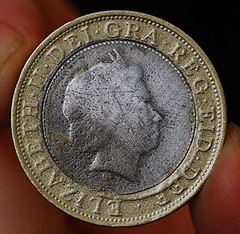 POLICE have smashed a forgery gang who planned to flood London with thousands of fake £2 coins during the
Olympics
POLICE have smashed a forgery gang who planned to flood London with thousands of fake £2 coins during the
Olympics

Counterfeit-coin-con-cracked.html)
CANADIAN MOOSE MONEY AND CARIBOU COINS
 About 75 years after Canadians began making a national pastime out of mistaking the caribou on their quarters for a
moose, the Royal Canadian Mint is selling a silver coin that depicts the real deal - alces alces, the king of all deer, the namesake beast of Moose Jaw, Sask., and Moosehead beer.
About 75 years after Canadians began making a national pastime out of mistaking the caribou on their quarters for a
moose, the Royal Canadian Mint is selling a silver coin that depicts the real deal - alces alces, the king of all deer, the namesake beast of Moose Jaw, Sask., and Moosehead beer.
 OK, I admit it - I thought it was a moose all along, too. But Rudolph the Red-Nosed Caribou?
-Editor
OK, I admit it - I thought it was a moose all along, too. But Rudolph the Red-Nosed Caribou?
-Editor
/6632976/story.html)
ARTICLE HIGHLIGHTS WEST POINT MINT FACILITY
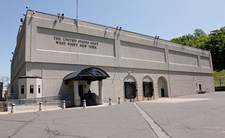 Mint officials gave the media a tour of their West Point plant Friday, with the Sept. 11 medal as the featured product.
Mint officials gave the media a tour of their West Point plant Friday, with the Sept. 11 medal as the featured product.
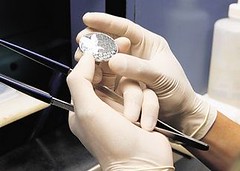
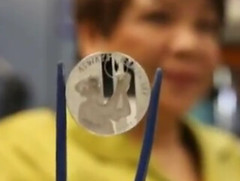

FEATURED WEB PAGE: KISSI MONEY
This week's Featured Web Page is Kissi Money or ‘Money with a Soul'.
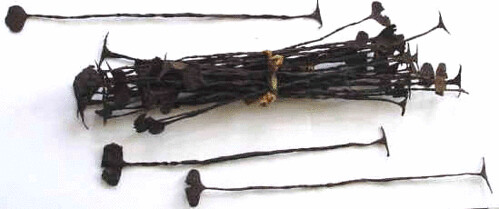
www.liberiapastandpresent.org/kissi.htm

